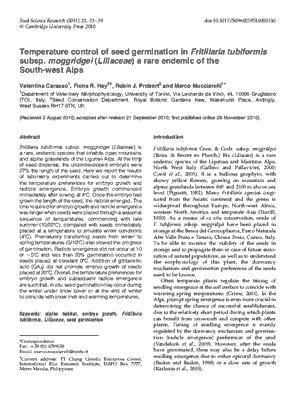NEWS 2011
Temperature control of seed germination in Fritillaria tubiformis subsp. moggridgei (Liliaceae) a rare endemic of the South-west Alps
Valentina Carasso¹, Fiona R. Hay², Robin J. Probert² and Marco Mucciarelli¹
Seed Science Research 21: 33-38(2011)
doi:10.1017/S0960258510000310
¹Department of Veterinary Morphophysiology, University of Torino, Via Leonardo da Vinci, 44, 10095 Grugliasco (TO), Italy
²Seed Conservation Department, Royal Botanic Gardens Kew, Wakehurst Place, Ardingly, West Sussex RH17 6TN, UK
Abstract
Fritillaria tubiformis subsp. moggridgei (Liliaceae) is a rare, endemic species that inhabits open mountains and alpine grasslands of the Ligurian Alps. At the time of seed dispersal, the underdeveloped embryos were 27% the length of the seed. Here we report the results of laboratory experiments carried out to determine the temperature preferences for embryo growth and radicle emergence. Embryo growth commenced immediately after sowing at 4°C. Once the embryo had grown the length of the seed, the radicle emerged. The time required for embryo growth and radicle emergence was longer when seeds were placed through a seasonal sequence of temperatures, commencing with late summer (10/20°C), compared with seeds immediately placed at a temperature to simulate winter conditions (4°C). Prematurely transferring seeds from winter to spring temperatures (5/10°C) also slowed the progress of germination. Radicle emergence did not occur at 10 or 25°C and less than 20% germination occurred in seeds placed at constant 0°C. Addition of gibberellic acid (GA3) did not promote embryo growth of seeds placed at 20°C. Overall, the temperature preferences for embryo growth and subsequent radicle emergence are such that, in situ, seed germinationmay occur during the winter under snow cover or at the end of winter to coincide with snow melt and warming temperatures.

